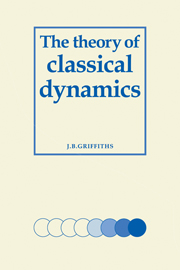Book contents
- Frontmatter
- Contents
- Prefaces
- Introduction
- 1 The Newtonian method
- 2 Space, time and vector notation
- 3 Force, mass and the law of motion
- 4 Newtonian relativity
- 5 Newtonian gravitation
- 6 Particle dynamics
- 7 Systems of several particles
- 8 Rigid body dynamics
- 9 Analytical dynamics
- 10 Variational principles
- 11 Hamilton–Jacobi theory
- Appendix list of basic results and definitions
- Suggestions for further reading
- Index
2 - Space, time and vector notation
Published online by Cambridge University Press: 25 October 2011
- Frontmatter
- Contents
- Prefaces
- Introduction
- 1 The Newtonian method
- 2 Space, time and vector notation
- 3 Force, mass and the law of motion
- 4 Newtonian relativity
- 5 Newtonian gravitation
- 6 Particle dynamics
- 7 Systems of several particles
- 8 Rigid body dynamics
- 9 Analytical dynamics
- 10 Variational principles
- 11 Hamilton–Jacobi theory
- Appendix list of basic results and definitions
- Suggestions for further reading
- Index
Summary
The subject of classical dynamics deals with the motion of bodies in space. Its aim is to provide models which are capable of accurately describing the way in which bodies change their position in space as time progresses. Thus the starting point for a study of dynamics must be a set of initial assumptions about the nature of space and time. These are primitive or foundational concepts which are necessary for the development of any theory of dynamics. Newton himself found it necessary to discuss these concepts in the first chapter of his Principia, although it is not necessary here to introduce his concepts of an absolute space and absolute time.
Writing at the end of the twentieth century, it is possible to assess the theory of classical dynamics in the light of the modern theories of relativity and quantum mechanics. The classical theory has ultimately been refuted, and the new theories indicate those aspects that require modification. According to the theories of relativity some of the weakest points of the classical theory are in fact its assumptions about space and time. It is therefore appropriate here to clarify the way in which these concepts are used in classical dynamics, and to contrast this with their use in the theories of relativity, before going on to describe the theory itself. We shall also take the opportunity in this chapter of introducing the vector notation which is so useful in classical dynamics as a consequence of its initial assumptions about space and time.
- Type
- Chapter
- Information
- The Theory of Classical Dynamics , pp. 16 - 34Publisher: Cambridge University PressPrint publication year: 1985



